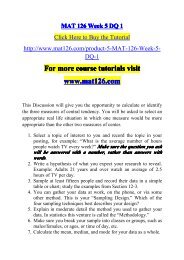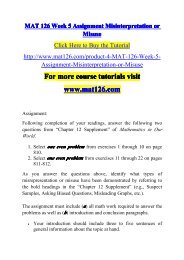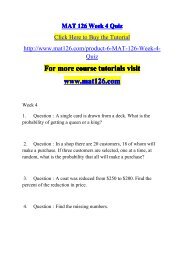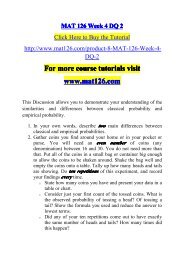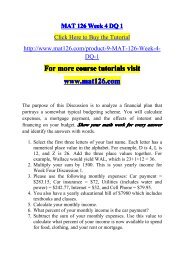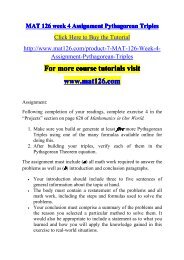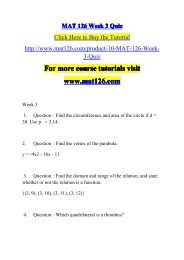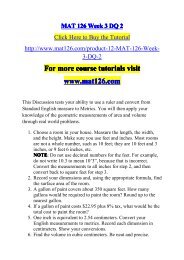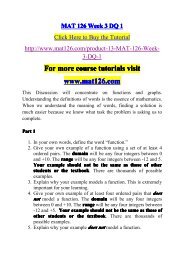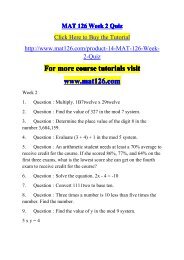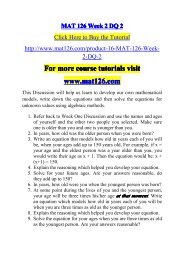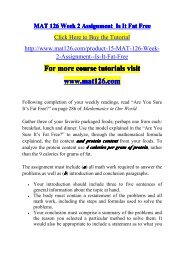MAT 126 Week 2 DQ 1
For more course tutorials visit www.mat126.com This Discussion should be an eye opener for most students. We will look at our food shopping trends and how we spend our money. The outcomes should reveal some interesting facts. 1. Save a cash register receipt from a shopping trip to the food market, or borrow one from a family member or friend. The cost of four prepackaged food items that are sold by weight and the cost of at least three fresh fruits, or vegetables need to appear on the receipt. If you have no access to a receipt with these items, then you will need to go to the store and write down the cost information, or find a grocery advertisement online. Do not use liquids such as milk, juice, or soda because these are sold by volume and not by weight. Also, do not include ingredients like flour, sugar, oil, dry beans, etc. because these items are not prepackaged foods. 2. Fruits and vegetables are sold by the pound. Add up your prices per pound for the fruits and vegetables and find the average cost per pound. (Example: If bananas are .79 per pound and apples are .59 per pound, the average is calculated like this: (.79 + .59)/2 = 1.38/2 = .69 per pound on average for the two fruits.) 3. Locate the weight of your prepackaged food items. (For exampl
For more course tutorials visit
www.mat126.com
This Discussion should be an eye opener for most students. We will look at our food shopping trends and how we spend our money. The outcomes should reveal some interesting facts.
1. Save a cash register receipt from a shopping trip to the food market, or borrow one from a family member or friend. The cost of four prepackaged food items that are sold by weight and the cost of at least three fresh fruits, or vegetables need to appear on the receipt. If you have no access to a receipt with these items, then you will need to go to the store and write down the cost information, or find a grocery advertisement online. Do not use liquids such as milk, juice, or soda because these are sold by volume and not by weight. Also, do not include ingredients like flour, sugar, oil, dry beans, etc. because these items are not prepackaged foods.
2. Fruits and vegetables are sold by the pound. Add up your prices per pound for the fruits and vegetables and find the average cost per pound. (Example: If bananas are .79 per pound and apples are .59 per pound, the average is calculated like this: (.79 + .59)/2 = 1.38/2 = .69 per pound on average for the two fruits.)
3. Locate the weight of your prepackaged food items. (For exampl
- No tags were found...
You also want an ePaper? Increase the reach of your titles
YUMPU automatically turns print PDFs into web optimized ePapers that Google loves.
<strong>MAT</strong> <strong>126</strong> <strong>Week</strong> 2 <strong>DQ</strong> 1Click Here to Buy the Tutorialhttp://www.mat<strong>126</strong>.com/product-17-<strong>MAT</strong>-<strong>126</strong>-<strong>Week</strong>-2-<strong>DQ</strong>-1For more course tutorials visitwww.mat<strong>126</strong>.comThis Discussion should be an eye opener for most students. We willlook at our food shopping trends and how we spend our money. Theoutcomes should reveal some interesting facts.1. Save a cash register receipt from a shopping trip to the foodmarket, or borrow one from a family member or friend. The costof four prepackaged food items that are sold by weight and thecost of at least three fresh fruits, or vegetables need to appear onthe receipt. If you have no access to a receipt with these items,then you will need to go to the store and write down the costinformation, or find a grocery advertisement online. Do not useliquids such as milk, juice, or soda because these are sold byvolume and not by weight. Also, do not include ingredients likeflour, sugar, oil, dry beans, etc. because these items are notprepackaged foods.2. Fruits and vegetables are sold by the pound. Add up your pricesper pound for the fruits and vegetables and find the average costper pound. (Example: If bananas are .79 per pound and applesare .59 per pound, the average is calculated like this: (.79+ .59)/2 = 1.38/2 = .69 per pound on average for the two fruits.)3. Locate the weight of your prepackaged food items. (Forexample, on a box of Frosted Flakes it says 15 oz.)4. Add up all of the weights for your prepackaged items in ounces,and then add up all of the costs for your four prepackaged items.




